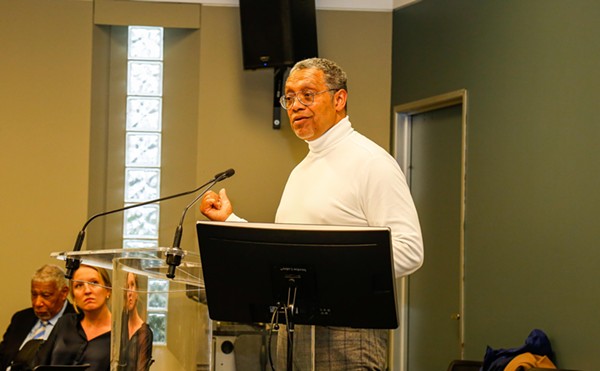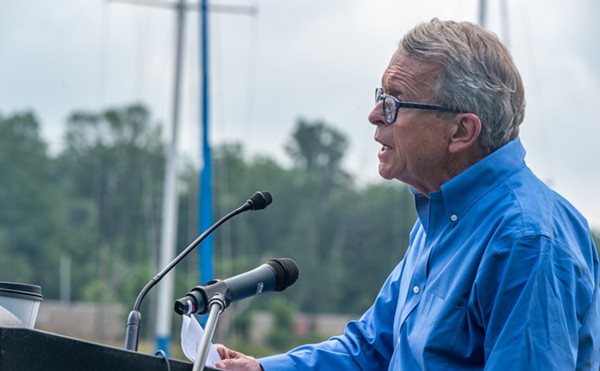This week, we brought you the story of how a major heroin ring operated on the east side of Cleveland and how a two-year investigation by the FBI and police brought down 92 people on federal and state charges. If you haven't read that yet, just click here. Below are two lessons from the story worth highlighting and a third lesson not included in the original story.
1. If you're a target in a major drug investigation, law enforcement is probably following you on social media.
If you have stacks of cash and a Gucci backpack, but don't instagram it, then do you really have stacks of cash and a Gucci backpack?
If you've been making money setting up large-scale heroin deals across the country, but don't tweet about spending it, then are you really a V.I.P.?
Tired of driving rentals, think I'll treat my self 2 a 2012Benz next week!😉
— Max Julian (@KeithvsMax) November 19, 2011
Apparently not. The Instagram picture came from Maceo Moore, a.k.a. Chase, and the tweet came from Keith Ricks; those two were the ringleaders of the ringleaders that went down in the federal investigation. They often switched up phone numbers and the cars they used, discussed "business" only in person, and issued threats about "snitches." But they couldn't not tweet about what they were doing and what they had. They had to let their Twitter and Instagram followers know they deserved respect on the streets, that they were people to be looked up to. But among the people who followed Keith Ricks on his social media accounts(688 on Twitter, 1,862 on Intstagram) were task force agents using his posts to corroborate evidence wiretapped phones already provided against him. After listening in on wiretapped calls between Ricks (in Atlanta) and his associates (in Cleveland) arranging an Atlanta heroin shipment, the FBI cites three specific posts from Keith Ricks in their June affidavit for his arrest:
On February 28, 2013, at approximately 6:55 p.m., KEITH RICKS, using the account "KeithvsMax," posted a photograph on Instagram apparently taken through the window of an airplane in flight. RICKS used the text, "Even in the sky the sun stays shinning on me." Using a Twitter account with the same username, "KeithvsMax," at approximately 7:09 p.m., RICKS posted the message, "Left the ghetto with a medal of honor & a fat bank roll." At approximately 11:12 p.m., RICKS used the same twitter account to post the message "Home sweet home ATL (Atlanta) drunk A.F. (as fuck)."
Here are those specific posts
Left the ghetto wit a medal of honor & a fat bank roll...
— Max Julian (@KeithvsMax) March 1, 2013
Home sweet home ATL drunk A.F
— Max Julian (@KeithvsMax) March 1, 2013
Instagram also helped corroborate evidence against him when his courier used a since-deleted account to post a picture of a selfie with the caption: "Back in the ghetto from the A on the morning side." Ricks is currently under investigation for past murders. It probably doesn't help that this tweet is out there:
Nigga talk ish until I send them boyz they way.. Do niggaz really want that Halo?
— Max Julian (@KeithvsMax) March 8, 2013
Maceo Moore, was a fan of Vine, Twitter's six-second video app. Here are some of his Vine links he tweeted:
The FBI already had the ability to listen to their phone calls, read their texts, use their phone's data to track their location, track the cars they used with a GPS unit (that could automatically shut off the engine, if needed), and watch over their homes with secretly installed cameras. Social media just further proved their case.
(Moore put out more than just social media posts that implicated himself. Read the story to see a music video, a trailer for his move "The Game Ain't For Everybody," and learn how he was infiltrated by undercover FBI agents posing as a documentary film crew)
2. Routine traffic stops that lead to huge drug busts aren't as random as you may think.
The success of a drug investigation depends on targets not knowing they're apart of an investigation until it's complete. A full-scale takedown of anybody the FBI knew was transporting heroin would tip off everybody else that they're being watched, so the they would direct local authorities, in marked squad cars, to conduct the stop for any other reason than that the FBI told them to (speeding, no turn signals, bad license plates, whatever) and find independent probable cause to search for drugs.
The opening section of the story describes the bust of two Cleveland-bound couriers, Lamar Egler and Lewis Hall, getting pulled over for not using a right turn signal in Joliet, Ill., and the police happening to find 5.6 kilograms of heroin in the trunk. Here's a news story from that arrest from the Joliet newspaper:
Police say a “phantom grandfather” led them to the largest heroin seizure in department history Tuesday night. At 8:54 p.m. tactical officers Aaron Bandy and Terrence Gruber were on patrol near Maple and Gougar roads when a Hyundai Genesis with Ohio license plates failed to signal when turning, Chief Mike Trafton said.
That arrest was actually orchestrated by Chicago FBI agents. Egler and Hall just purchased the heroin from some of the FBI's targets whose phones were tapped and house was watched. Their boss back in Cleveland and the Joliet targets continued to communicate as if the FBI wasn't listening in.
On May 25, Brandy Bates was pulled over by the Ohio State Highway Patrol in Medina County. Troopers happened to find a bunch of marijuana and cash, and the incident report says she was speeding. So does the news story:
A Georgia woman is facing a felony drug charge after Ohio State Highway Patrol troopers seized marijuana, worth more than $6,000, during a traffic stop on an interstate in Medina County Saturday morning. Troopers stopped a 2009 Volkswagen Tiguan with Ohio registration for a speed violation on Interstate 71 near milepost 204 at 10:40.
But, again, the FBI was behind that bust as part of the Cleveland investigation. She was an associate of Ricks and after agents intercepted calls from his phone discussing with Bates her plan to drive to Atlanta and back for a shipment of heroin that he'd help distribute, the FBI installed a GPS tracking device on her car. When she was on her way back, agents directed the troopers to pull her over. They missed the heroin, apparently, because the smell of the marijuana was too overpowering for the drug-sniffing dog. Agents then listened to conversations Ricks had about her arrest.
There are several of these orchestrated busts referenced in the documents throughout the two-year investigation, including a traffic stop of Frederick Darling that gave proof that he supplied heroin to Eugene Miller and more.
3. Drug dealers and the detectives investigating them both like The Wire.
If the activities in this story seem similar to The Wire — HBO's crime series based on the drug trade in Baltimore — those similarities were not lost on the subjects of it. Members of the main group of six posted on social media about The Wire on several occasions, including this picture from recently-indicted Dionte Thompson (a brother of Keith Ricks and dealer based on the East 117th St. and St. Clair intersection);
On the other side, at least one Cleveland homicide detective assigned to work the investigation for the task force is a big fan of the show, using his personal Twitter account to retweet these:
"I'm murder police. I got a double on my plate, I'm gonna work it" -Bunk #TheWire
— The Wire (@WireFans) September 24, 2013
Come at the King you best not miss | http://t.co/YGHQqtnEkn #TheWire
— The Wire (@WireFans) August 30, 2013
"Hey what kind of detective would I be if I couldn't track a white woman in Baltimore right?" -McNulty #thewire
— The Wire (@WireFans) April 5, 2013
If you haven't read the story yet, here's the link again.
If you haven't watched the wire yet, what are you waiting for?














